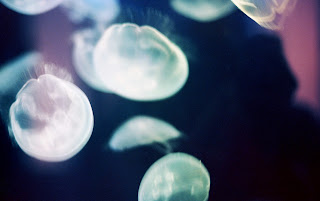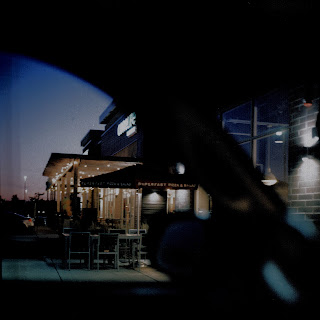A Year on Film
I was in Wisconsin, Lake Geneva actually. It was quite cold, just the beginning of winter. I was very little at the time, but I recall walking into a store called the Dancing Unicorn. They had a lot of really neat things: hand engraved flasks, small carved and inlaid wooden boxes, tons of beautiful old books, and way in the back--some old cameras. There was a small hand-written sign on the shelf, it said "please do not trip the shutters." I had no idea what this meant at the time. If I just held it, would something break? They were weird, these little old boxes, some with large metal disks on the top with a light bulb. I was intrigued. My camera was a little plastic Kodak C613 that I had just gotten from my aunt the Christmas or two before. Point and shoot digital camera, nothing special, I took photos mostly of people's shoes and Lego bricks. Then there below, way below, was a Certo Dolly camera from the 1930s. I liked how it looked. Old, but not like a box. Old like a camera. A few months later, it became a thoughtful gift to me from my mom.
I put a couple rolls of film through this camera when I got it, and I knew nothing about exposure. I got back a shot or two, a doorframe, a stuffed animal, and it sat largely unused for more than a decade. Partly due to the format. 127 is obsolete, hardly anyone develops it, yet alone sells it. I continued to move up the ladder, new cameras--all digital--shooting everything. Eventually my knowledge of exposure increased, as did my desire for better composition. Then a year ago I purchased my first SLR. I had a DSLR, but I wanted to give film another try. I loved the look, the resolution, the color, the contrast, the organic feel...I wanted that in my photos. I also loved the hands-on approach of developing and printing myself, without a computer system doing it for me. It was a much more rewarding experience to do the work and get results, rather than have the work already done. I had researched film cameras for a couple years prior, but never wanted to drop the cash on something I felt would be difficult to use; yet I was growing more and more frustrated with my digital camera. So I loaded a Canon F-1 into my cart. It had the things I wanted it to have: backup mechanical release, removable finder (for unique angles), but it lacked the multiple exposure leaver its predecessor, the A-1 had. Of course the camera I really wanted was the Nikon F3, specifically the Titanium model. I didn't have 300-400 for the base brass model, or 600-700 for the T version, so I settled on the F-1. Or thought about it at least. That was until I found a listing for a beat up F3 body for 160$. It was working, or so the seller claimed. Dropped a few times here and there, some major dents, but if it was working, well...this was the camera I wanted. The lens compatibility was not to be reckoned with, the accuracy, the design, all for 160 US dollars. I bit the hook. Of course it was my Norwegian friend Isak Rundereim who basically said "you god-forsaken half-witted imbecile, why the *********** wouldn't you buy an F3??" (dramatization). So I did. The End.
Just Kidding.
The F3 was by my side every single day for the first 7 or 8 months. In that time, I didn't touch digital to take a serious photo once. I learned as much as I could about film stocks and developing, and just shot. It fit my style and workflow perfectly, and worked the second I had it out of the box. It never once failed in the slightest bit. I bought up the nicest lenses I could find, found out what my favorite film stocks were (ektar 100 and HP5) and met tons of cool people. The photos I got back off this camera were amazing. They blew me away, couldn't tell they weren't digital, not that I cared. They were so much richer than anything I had created before. They were personally pleasing and made me enjoy what I did to an extend that I previously hadn't even considered. Everything about me as a photographer got better. My understanding of exposure and composition, my ability to quickly manual focus, my ability to see a shot and let another go. It also hurt my wallet, but the photos I got made it all worthwhile.
After shooting on 35, developing, even darkroom printing, I purchased a Hasselblad. I wanted to shoot medium format and Polaroid film, but didn't want to buy two separate cameras. Instead I wanted to use an instant film back for medium format. A good lens plus instant film seemed like a fantastic combo. My other choice was the Mamiya RZ67. The RB was out of the question because it had me cock the back as well as the shutter separately. The RZ however was all one motion...the only thing was that it was the size of a cinder block and weighed about the same.
"You keep saying that"
-Isak
This was one of the major things that pushed me towards the Hasselblad. I also liked the square format quite a bit. I had shot a Rolleiflex earlier, broken and desolate, but it took a really good shot. Zeiss optics had grown on me after that and the Hasselblad seemed like the obvious choice. So I set down and repaired a mother load of typewriters and purchased a Hasselblad 500c from 1966. I had mixed feelings about it, the dim screen, the difficulty in achieving sharpness, but it took good Polaroids (FP100c) and it had great bokeh.
The rest, as they say is History. I took so many photos, over 2,000, all on film, and I don't regret a single thing. Sure, I'll continue to shoot digital, but in today's era, there is still a place for film.
I know a lot of people have gone back to it just as they came crawling back to typewriters. The Hipsters as they call them. Coffee slurping, record spinning hippie-wannabes. But that isn't why I wanted to shoot film. I wanted to shoot it, not because it is better or worse than digital, but because it gave results I was more pleased with. With digital, anyone can shoot and get the same great results every single time, with film, that identical result takes effort and thought. That is what makes the process rewarding for me. It wasn't a computer that made that photo, it was me.
That's all that it is. Digital is consistency, Film is work. They're both capable of incredible detail and high resolution, as well as amazing color and depth. Film does naturally have a higher tonal and dynamic range, but digital has been catching up. The one thing digital can't do however, is replicate the organic feel of film. Digital is nothing more than neat rows of pixels. Film is an organic arrangement of silver-halide crystals, responding to photons and wavelengths. In a sense, it's a true image, whereas digital is a replication.
That's all, so here are some of the shots I've taken. Not all, find me on social media for that, visit my website and look under processes for some Polaroid stuff. http://lucasdul.com
Ilford Xp2
XP2
HP5
Tri-X
Ektar 100 +2
HP5
Ektar 100 +2
HP5
Ektar 100
Portra 400
Color Superia 400
Ektar 100
HP5
Portra 400
Portra 400
Ektar 100
Portra 400 (edit)
Portra 400
Portra 400
HP5
HP5
Portra 400
Color Plus 200
Color Plus 200
HP5
HP5
Ektar 100 +2
Ektar 100 +2
Ektar 100 +2
Ektar 100 +2
Ektar 100 +2 (panoramic crop 135)
Ektar 100
Ektar 100
Ektar 100
Ektar 100
Ektar 100
Ektar 100
Ektar 100
HP5
HP5
Ektar 100 +2
Ektar 100 +2
HP5
Tri-X
Ektar 100
FP100c
HP5
Ektar 100 +2
Portra 400
HP5
Ektar 100 +2
Portra 400
HP5































































Comments
Post a Comment